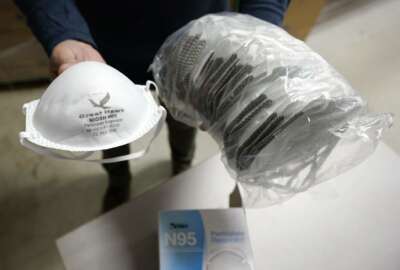Amid explosion in DoD’s use of OTAs, myths abound about how and whether to use them
DoD's use of other transaction agreements has expanded ten-fold in the past five years, but even inside the acquisition workforce, there are still persistent myths...
Other Transaction Agreements have been around since the days of the Space Race. But until recently, OTAs, which almost entirely bypass the government’s usual procurement rules, had been a little-used feature of the acquisition system.
At least in the case of the Defense Department, it’s not a small niche anymore. Since the 2015 Defense authorization bill, when Congress vastly expanded the types of acquisitions eligible for OTAs in DoD, they’ve seen explosive growth.
In fiscal 2016, DoD signed 342 OTAs worth just over $1.4 billion. In FY 2020, the numbers grew to more than 3,210 agreements, valued at $16.2 billion, according to figures from the Federal Procurement Data System. FY 2021 data haven’t been completely reported yet, but last year appears to be on track for an even larger total.
Despite the massive expansion in OTA use, the authority, and when and how it can be used, is still shrouded in a certain degree of mystery, even inside DoD’s own acquisition community.
“If I had a penny for every time I’ve had a client come in and say, ‘I heard OTA is the best thing since sliced bread, I want to pivot my requirement to OTA,’ I would probably be on an island somewhere,” said Hallie Balkin, a DoD procurement attorney who currently leads an education effort specific to other transaction agreements at Defense Acquisition University (DAU).
During an interview for Federal News Network’s On DoD, Balkin said she was attracted to the DAU role after having seen numerous other workshops and seminars in which misinformation about OTAs was being spread throughout the acquisition workforce.
DAU’s approach — as part of the university’s transition from mostly classroom-based instruction to a more online-focused learning “platform” — has been to offer regular training events under the banner of “OTA Today.”
Instead of teaching a few dozen students at a time, they reach hundreds per event, and by design, they’re open not just to government acquisition professionals but also to vendors and anyone else who has an interest in the subject. DAU also offers coaching to individual program offices who are looking for advice on whether an OTA might make sense for a particular project.
Balkin said part of the effort has been to correct myths about what OTAs can and can’t do, and where they are and aren’t appropriate. Although Congress set very few rules for how the authority can be used, it’s not a complete blank check to circumvent the Federal Acquisition Regulation.
The biggest constraint is that the work involved has to constitute something that DoD can defensibly argue is a “prototype” — something new or novel.
“It has to be something we’re doing differently,” she said. “If it’s just that we’re stuck in a sole-source contract and it’s taking forever, or we’re not happy with the vendor, we can’t just pivot to an OT because we heard it’s the new trendy, cool thing to do.”
On the other hand, the definition of “prototype” became vastly more flexible when Congress expanded DoD’s authority in the 2015 NDAA. Before that, OTAs could only be used to prototype potential future weapons systems.
The 2015 change meant the Pentagon could now use the prototyping authority for anything “directly related to enhancing the effectiveness of military personnel,” including new components, materials and supporting platforms.
A 2018 Government Accountability Office decision put more meat on the bones of the definition, setting what Balkin said is now considered a “quasi” two-prong test in the OTA community: whether the specific technological approach in question has ever been deployed in the same system before, and whether the government at large has already done essentially the same thing with the same technology. If the answer to both questions is “no,” it’s likely safe to consider it a “prototype.”
“That means if I want to get some sort of new technology from a vendor like Best Buy, and if it’s never been put on, say, a Navy machine that has specific NMCI security requirements, I can constitute that as a proper prototype and put it on every single Navy machine to see if it works, and then move on to eventual production,” Balkin said. “That’s huge, because staying up with technology and avoiding obsolescence is one of our biggest challenges. So if we can now move in this expeditious manner and get the technology as it’s being developed, before it’s outdated, that’s one of the really cool things about OTA.”
Even as spending on OTA prototypes has exploded, the military services and Defense agencies have sometimes struggled to move those projects into large-scale use.
In a subsequent NDAA, Congress gave DoD explicit authority to move OTA prototypes directly into production — as long as the initial prototype was subject to some kind of competition, and as long as potential vendors were on notice that they might not have another chance to compete for a production award.
That follow-on production authority has been used sparingly so far, partly because of what Balkin said is another persistent myth around OTAs in DoD’s acquisition community.
“It’s one of the ones that’s most frustrating. I keep hearing – even from attorneys in the federal government — that [a production OTA] is considered a sole-source contract, and that we have to do a justification and approval before we move to production,” she said. “That’s absolutely not the case. We have statutory authority to move to a direct award, which is very different from a sole-source award. That’s a FAR-based concept that requires a whole different set of things. If we have a prototype ready to go and we follow the rules, if we’re transparent, if we’ve acted ethically, that’s the perfect time to move into production. That’s what we should be doing in order to keep up with technology and remaining relevant.”
DoD procurement officials can also sometimes be attracted to OTAs under the mistaken belief that they’re a get-out-of-jail-free card that immunizes their programs from bid protests at the Government Accountability Office and the Court of Federal Claims.
That, Balkin said, is still a persistent myth. Even though GAO and the claims court are not going to scrutinize things like individual evaluation factors in the way they would during a FAR-based procurement, both protest venues are more than open to considering whether an agency has used its OTA authority properly in the first place — and sustaining bid protests if they haven’t.
“GAO has specifically stated that it’s not going to go through our documents and look at things like strengths, significant weaknesses, deficiencies — those are all FAR-based terms,” she said. “But they are going to look at whether we used an OTA appropriately. Are you using an OT arrangement to circumvent the FAR, or are you kind of cherry picking what you want from the FAR and calling it an other transaction? Or, are you going into production before the prototype has been successfully completed, or going out of scope? OTAs are certainly not free from litigative risks.”
And Balkin said she generally counsels DoD requirements owners that just because they legally can use an OTA doesn’t always mean they should.
Even though the authority technically exempts the department from almost all of the usual bureaucratic steps that were meant to double-check that principles like fair competition, transparency and accountability are being followed, DoD still needs to find ways to achieve those ends.
“Congress gave us this authority, and it’s our job to make sure we mitigate abuse and misuse, because we don’t want Congress to take it away,” she said. “This is not carte blanche to act in any way that we see fit. Even though we have a small ruleset, we still are obligating U.S. taxpayer dollars. Agreements officers might have to think a little more critically and outside the box, but it needs to be fair and ethical. The overall notion should be, if someone were to know what we’re doing, would we be nervous? If the answer is yes, then there’s a problem there.”
Copyright © 2025 Federal News Network. All rights reserved. This website is not intended for users located within the European Economic Area.
Jared Serbu is deputy editor of Federal News Network and reports on the Defense Department’s contracting, legislative, workforce and IT issues.
Follow @jserbuWFED






